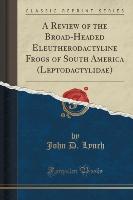- Start
- A Review of the Broad-Headed Eleutherodactyline Frogs of South America (Leptodactylidae) (Classic Reprint)
A Review of the Broad-Headed Eleutherodactyline Frogs of South America (Leptodactylidae) (Classic Reprint)
Angebote / Angebote:
Excerpt from A Review of the Broad-Headed Eleutherodactyline Frogs of South America (Leptodactylidae)
No author has united all the species into a single genus although the idea seems to have been considered at various times (see Rivero, 1961). Fourteen trivial names are available for broad-headed eleutherodactylines. These are disposed in two genera: Amblyphrynus (ingeri Cochran and Goin) and Eleutherodactylus (biporcatus Peters, bufoniformis Boulenger, cornutus Jiménez de la Espada, florulentus Cope, gulosus Cope, koki Melin, macrocephalus Peracca, maussi Boettger, megacephalus Cope, napaeus Jiménez de la Espada, pelviculus Cope, rugosus Peters, and sulcatus Cope).
In Central America, the broad-headed frogs occur from Honduras to Panama. Either two species (biporcatus and bufoniformis) are recognized or biporcatus is fragmented into three species - biporcatus (with a single putative synonym, napaeus), florulentus, and rugosus (with three putative synonyms, gulosus, megacephalus, and pelviculus). The Central American frogs are under study by J. M. Savage and further comment on them is restricted to South American populations. I consider the Central American broad-headed frogs as constituting two species, biporcatus and bufoniformis.
All names applied to South American specimens of broad-headed frogs are currently recognized, with the exception of napaeus. I do not consider napaeus a synonym of biporcatus.
Historical Résumé
Peters (1864) named Strabomantis biporcatus from Veragua ( = western Panama). He noted the relationships of this frog to Hylodes ( = Eleutherodactylus), in that both groups are partially characterized by having "adhesive" discs on the digits, but separated them because Strabomantis had a broad head and narrow interorbital region. The subsequent history of the Central American taxa is summarized by Dunn (1931), Noble (1918), and Taylor (1952). I follow Dunn in recognizing two Central American species of "broad-headed" eleutherodactylines, biporcatus, florulentus, gulosus, megacephalus, pelviculus, and rugosus are considered conspecific.
Jiménez de la Espada (1870) named Limnophys cornutus and L. napaeus from the Río Suno near San Jose de Motí, Napo Province, Ecuador. He later (1872) considered Limnophys a synonym of Strabomantis, L. napaeus a synonym of S. biporcatus, and cornutus to be a valid species of Strabomantis. Both species described by Jimenez de la Espada had smooth skin on the venter and coarsely tuberculate skin on the dorsum. The holotype of L. napaeus was 50 mm SVL, comparable sized biporcatus have nearly smooth skin above and I thus reject Jimenez de la Espada's synonymy of napaeus with biporcatus.
About the Publisher
Forgotten Books publishes hundreds of thousands of rare and classic books. Find more at www.forgottenbooks.com
This book is a reproduction of an important historical work. Forgotten Books uses state-of-the-art technology to digitally reconstruct the work, preserving the original format whilst repairing imperfections present in the aged copy. In rare cases, an imperfection in the original, such as a blemish or missing page, may be replicated in our edition. We do, however, repair the vast majority of imperfections successfully, any imperfections that remain are intentionally left to preserve the state of such historical works.
Folgt in ca. 5 Arbeitstagen




